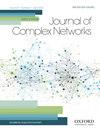用简单复合体表示的高阶网络中的一些广义中心性
IF 1.5
4区 数学
Q2 MATHEMATICS, INTERDISCIPLINARY APPLICATIONS
引用次数: 0
摘要
高阶相互作用,即群大小大于2的单位之间的相互作用,是各种复杂系统跨尺度的基本结构特征。简单复合体是一种组合对象,它可以捕获和模拟给定复杂系统中存在的高阶相互作用,从而将复杂系统表示为包含简单体的高阶网络。在这项工作中,一个给定的简单复合体被视为d-不相容简单复合体的有限并。因此,为了将复杂系统表示为由捕获系统中存在的所有阶的相互作用的简单复合体给出的高阶网络,使用了维数为d + 1且阶数适当的对称邻接张量a (d)族。每个邻接张量A(d)代表一个d不相容的简单复合体,当d≥2时,它代表系统的唯一高阶相互作用。为了表征d-不相容单纯配合物的结构,通过发展单纯配合物的广义行走和广义距离的概念,建立了广义结构中心性指标即广义中间中心性和广义亲密中心性的概念。广义中心指数量化了Δ -简单面对任何d-不相容的简单络合物Δ的贡献,其中Δ <d,如果d≥2,它描述了Δ -面对Δ的高阶相互作用的贡献。这些广义的中心性指数提供了局部结构描述,从而导致对包含高阶网络的简单复杂的中尺度见解。建立了一个重要的定理,提供了用邻接张量的不可约性来表征d-不相容简单复合体的连通性的一般技术。在这项工作中发展的概念以及在d-排他简单复合体中广义单纯形缺失的概念已经用例子说明了。文中还讨论了缺失对配合物广义中心性的影响。本文章由计算机程序翻译,如有差异,请以英文原文为准。
Some generalized centralities in higher-order networks represented by simplicial complexes
Abstract Higher-order interactions, that is, interactions among the units of group size greater than two, are a fundamental structural feature of a variety of complex systems across the scale. Simplicial complexes are combinatorial objects that can capture and model the higher-order interactions present in a given complex system and thus represent the complex system as a higher-order network comprising simplices. In this work, a given simplicial complex is viewed as a finite union of d-exclusive simplicial complexes. Thus, to represent a complex system as a higher-order network given by a simplicial complex that captures all orders of interactions present in the system, a family of symmetric adjacency tensors A(d) of dimension d + 1 and appropriate order has been used. Each adjacency tensor A(d) represents a d-exclusive simplicial complex and for d≥2 it represents exclusively higher-order interactions of the system. For characterizing the structure of d-exclusive simplicial complexes, the notion of generalized structural centrality indices namely, generalized betweenness centrality and generalized closeness centrality has been established by developing the concepts of generalized walk and generalized distance in the simplicial complex. Generalized centrality indices quantify the contribution of δ-simplices in any d-exclusive simplicial complex Δ, where δ<d and if d≥2, it describes the contribution of δ-faces to the higher-order interactions of Δ. These generalized centrality indices provide local structural descriptions, which lead to mesoscale insights into the simplicial complex that comprises the higher-order network. An important theorem providing a general technique for the characterization of connectedness in d-exclusive simplicial complexes in terms of irreducibility of its adjacency tensor has been established. The concepts developed in this work together with concepts of generalized simplex deletion in d-exclusive simplicial complexes have been illustrated using examples. The effect of deletions on the generalized centralities of the complexes in the examples has been discussed.
求助全文
通过发布文献求助,成功后即可免费获取论文全文。
去求助
来源期刊

Journal of complex networks
MATHEMATICS, INTERDISCIPLINARY APPLICATIONS-
CiteScore
4.20
自引率
9.50%
发文量
40
期刊介绍:
Journal of Complex Networks publishes original articles and reviews with a significant contribution to the analysis and understanding of complex networks and its applications in diverse fields. Complex networks are loosely defined as networks with nontrivial topology and dynamics, which appear as the skeletons of complex systems in the real-world. The journal covers everything from the basic mathematical, physical and computational principles needed for studying complex networks to their applications leading to predictive models in molecular, biological, ecological, informational, engineering, social, technological and other systems. It includes, but is not limited to, the following topics: - Mathematical and numerical analysis of networks - Network theory and computer sciences - Structural analysis of networks - Dynamics on networks - Physical models on networks - Networks and epidemiology - Social, socio-economic and political networks - Ecological networks - Technological and infrastructural networks - Brain and tissue networks - Biological and molecular networks - Spatial networks - Techno-social networks i.e. online social networks, social networking sites, social media - Other applications of networks - Evolving networks - Multilayer networks - Game theory on networks - Biomedicine related networks - Animal social networks - Climate networks - Cognitive, language and informational network
 求助内容:
求助内容: 应助结果提醒方式:
应助结果提醒方式:


